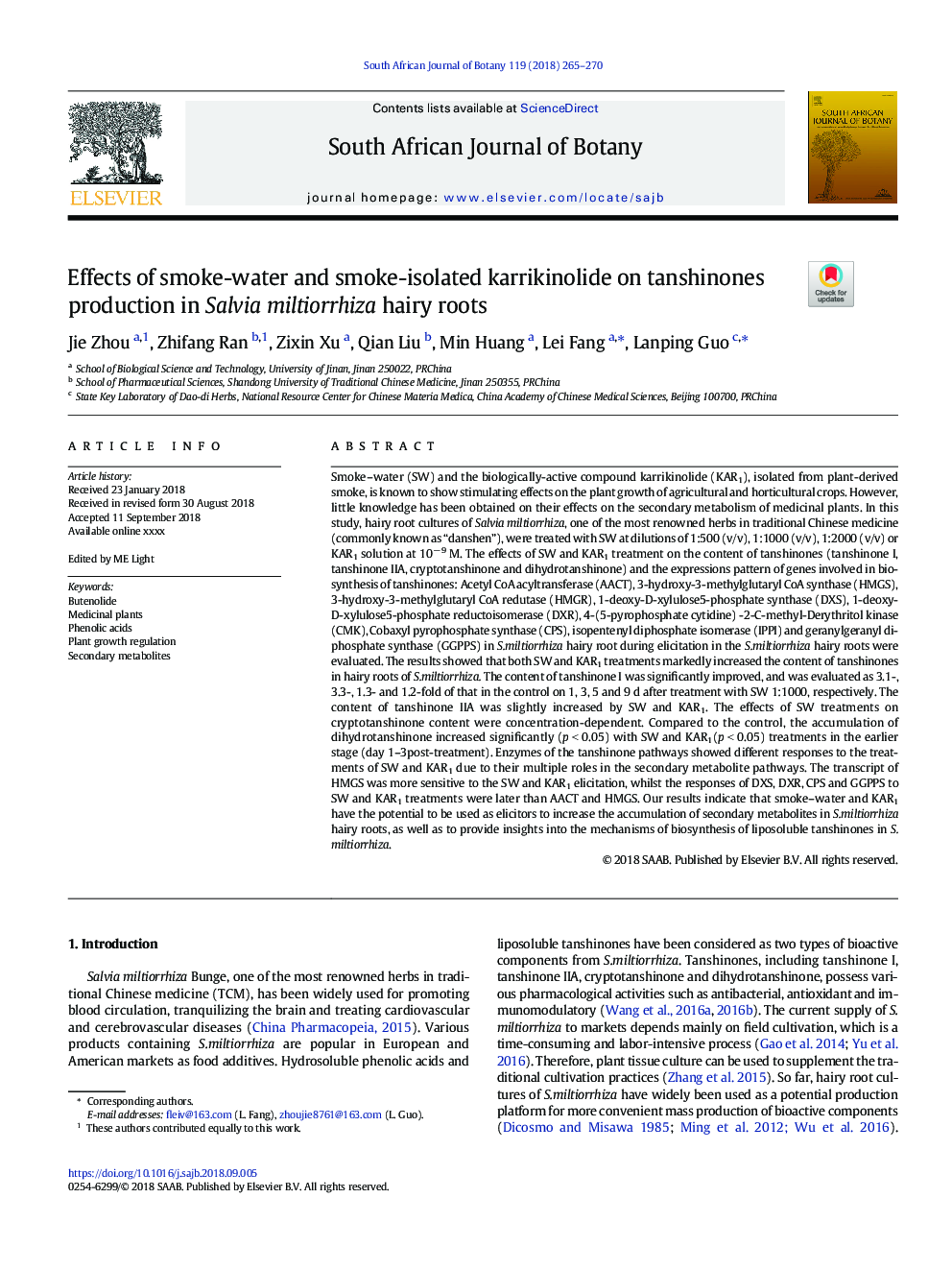| کد مقاله | کد نشریه | سال انتشار | مقاله انگلیسی | نسخه تمام متن |
|---|---|---|---|---|
| 11032631 | 1645335 | 2018 | 6 صفحه PDF | دانلود رایگان |
عنوان انگلیسی مقاله ISI
Effects of smoke-water and smoke-isolated karrikinolide on tanshinones production in Salvia miltiorrhiza hairy roots
دانلود مقاله + سفارش ترجمه
دانلود مقاله ISI انگلیسی
رایگان برای ایرانیان
کلمات کلیدی
موضوعات مرتبط
علوم زیستی و بیوفناوری
علوم کشاورزی و بیولوژیک
علوم زراعت و اصلاح نباتات
پیش نمایش صفحه اول مقاله

چکیده انگلیسی
Smoke-water (SW) and the biologically-active compound karrikinolide (KAR1), isolated from plant-derived smoke, is known to show stimulating effects on the plant growth of agricultural and horticultural crops. However, little knowledge has been obtained on their effects on the secondary metabolism of medicinal plants. In this study, hairy root cultures of Salvia miltiorrhiza, one of the most renowned herbs in traditional Chinese medicine (commonly known as “danshen”), were treated with SW at dilutions of 1:500 (v/v), 1:1000 (v/v), 1:2000 (v/v) or KAR1 solution at 10â 9â¯M. The effects of SW and KAR1 treatment on the content of tanshinones (tanshinone I, tanshinone IIA, cryptotanshinone and dihydrotanshinone) and the expressions pattern of genes involved in biosynthesis of tanshinones: Acetyl CoA acyltransferase (AACT), 3-hydroxy-3-methylglutaryl CoA synthase (HMGS), 3-hydroxy-3-methylglutaryl CoA redutase (HMGR), 1-deoxy-D-xylulose5-phosphate synthase (DXS), 1-deoxy-D-xylulose5-phosphate reductoisomerase (DXR), 4-(5-pyrophosphate cytidine) -2-C-methyl-Derythritol kinase (CMK), Cobaxyl pyrophosphate synthase (CPS), isopentenyl diphosphate isomerase (IPPI) and geranylgeranyl diphosphate synthase (GGPPS) in S.miltiorrhiza hairy root during elicitation in the S.miltiorrhiza hairy roots were evaluated. The results showed that both SW and KAR1 treatments markedly increased the content of tanshinones in hairy roots of S.miltiorrhiza. The content of tanshinone I was significantly improved, and was evaluated as 3.1-, 3.3-, 1.3- and 1.2-fold of that in the control on 1, 3, 5 and 9â¯d after treatment with SW 1:1000, respectively. The content of tanshinone IIA was slightly increased by SW and KAR1. The effects of SW treatments on cryptotanshinone content were concentration-dependent. Compared to the control, the accumulation of dihydrotanshinone increased significantly (pâ¯<â¯0.05) with SW and KAR1(pâ¯<â¯0.05) treatments in the earlier stage (day 1-3post-treatment). Enzymes of the tanshinone pathways showed different responses to the treatments of SW and KAR1 due to their multiple roles in the secondary metabolite pathways. The transcript of HMGS was more sensitive to the SW and KAR1 elicitation, whilst the responses of DXS, DXR, CPS and GGPPS to SW and KAR1 treatments were later than AACT and HMGS. Our results indicate that smoke-water and KAR1 have the potential to be used as elicitors to increase the accumulation of secondary metabolites in S.miltiorrhiza hairy roots, as well as to provide insights into the mechanisms of biosynthesis of liposoluble tanshinones in S.miltiorrhiza.
ناشر
Database: Elsevier - ScienceDirect (ساینس دایرکت)
Journal: South African Journal of Botany - Volume 119, November 2018, Pages 265-270
Journal: South African Journal of Botany - Volume 119, November 2018, Pages 265-270
نویسندگان
Jie Zhou, Zhifang Ran, Zixin Xu, Qian Liu, Min Huang, Lei Fang, Lanping Guo,